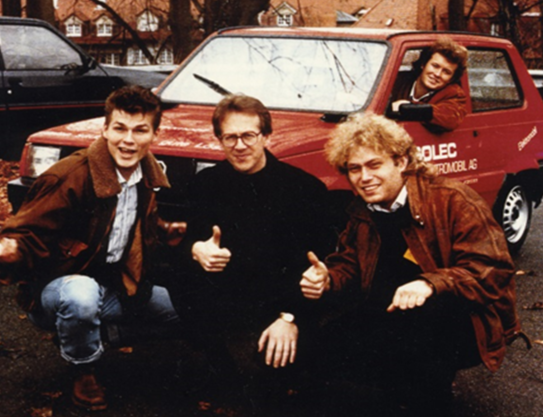Norway has come a long way since 1987, when Bellona’s president, Frederic Hauge, plugged the organization’s first electric car into an extension cable he ran out the window of his office in Oslo.
Norway has come a long way since 1989, when Bellona’s president, Frederic Hauge, plugged the organization’s first electric car into an extension cable he ran out the window of his office in Oslo.
The car, a squat triangular thing, was barely legal to drive. The bureaucracy for registering it was a nightmare, and you could only go 45 kilometers before you had to plug it in again. Only two passengers could squeeze into it – and only if they held their breath and only if they had both skipped dinner. It was the right thing to do for the environment, but nobody was too hopeful about something like this catching on.
Yet over the last year, a new trend on Norway’s roads proved Hauge and the funny little clown car he imported from Sweden 30 years ago were on to something.
According to the Norwegian Road Federation, 52 percent of all cars sold in the country in 2017 were electric or hybrid, marking the first time in any major driving economy that environmentally friendly sales outpaced the their primarily gas and diesel driven counterparts. And that’s up from the previous year, when electric and hybrids made up 40 percent of all cars sold in Norway.
 Bellona's former General Director Nils Bøhmer, far left, plugs in the Park Inn's new e-car charger.
Credit: Lev Fedorov
Bellona's former General Director Nils Bøhmer, far left, plugs in the Park Inn's new e-car charger.
Credit: Lev Fedorov
What’s more, said the Federation, 21 percent of cars sold in Norway last year were purely electric, and by the end of this year, the Federation says it expects fully a quarter of the cars sold in the country to be powered by nothing more than emissions free electricity.
What makes that figure all the more impressive is how well cars were selling last year overall. On the whole, dealers in Norway, a country of 5 million people, moved 158,650 automobiles, making it the third best year for car sales ever, topped only by 1985 and 1986.
All of this puts Norway in the fast lane to realize its goal of becoming the first country to dump the sale of gas and diesel powered cars altogether in favor of electric cars only by 2025. By now, the country has more than 120,000 purely electric cars on its roads – and sellers are having a hard time keeping up with demand. The Norwegian Road Federation said even more electric cars would have sold this year had so many drivers not been holding out for the Tesla Model 3.
 Bellona's e-car charger in Murmansk.
Credit: Bellona
Bellona's e-car charger in Murmansk.
Credit: Bellona
The United Kingdom and France are trying to catch up, but they won’t stop selling gas cars in favor of electric ones until 2040. China, meanwhile, is trying its hand at an e-car revolution of its own as it works to phase out emissions producing cars with regulations on car makers, generous Norwegian-style subsidies to e-car owners, and throwing government weight behind building millions of EV charge points.
Still, going all electric is an audacious goal for Norway, a country that owes so much of what it has to being Western Europe’s biggest oil exporter – and the road for e-car drivers hasn’t always been as smooth as it is today.
Exactly three decades ago, Hauge spent three years jumping through bureaucratic hoops to get his e-car road legal. Then, in 1995, he teamed up with Morten Harket, the frontman for the 80s Norwegian heartthrob act A-Ha, to showcase the environmental benefits of electric mobility. The two hit Norway’s open road – blowing through its expensive tolls, refusing to pay up.
Their freewheeling civil disobedience led to Oslo carving out generous tax incentives for e-car owners, giving them a free pass through the city’s eye-popping tolls and offering free e-car charging parking spots for owners once they arrive.
 Bellona founder Frederic Hauge after completing a trip from Oslo to Murmansk in Tesla Model S in 2014.
Credit: Bellona
Bellona founder Frederic Hauge after completing a trip from Oslo to Murmansk in Tesla Model S in 2014.
Credit: Bellona
And not only that. They get to ride on ferries for free and they get coveted passage through bus lanes in Norway’s urban centers – all on top of a tax break at registration that can make electric cars as much as 30 percent cheaper than their gas and diesel driven cousins.
Still, some have tried to argue that the perks of this high-voltage revolution are getting a little too sweet. In October, Oslo published a budget that would have gutted tax breaks on electric cars that weigh more than two metric tons. But outcry prompted the incoming government to give that budget a miss, and instead promise to uphold the previous government’s vow to preserve the current e-car incentive package until 2020.
And Bellona’s love of the electric open road isn’t confined to just Norway anymore. The group’s original pluck is paying off in places as unlikely for e-cars as Russia.
This past June, Bellona gave the Park Inn hotel in Murmansk an e-car charger of its own – a follow up gift on an electric car trek Hauge mounted across Norway to Russia’s Arctic capital in 2014, where he found it was hard to recharge his Tesla.
Now, Bellona has signed on with regional authorities in Murmansk to promote a series of charge stations to connect Russia’s northwest to neighboring Norway and Finland.
True, charging stations are a small start in Murmansk, a city where there are fewer than 10 electric cars registered. But as Norways’ roaring success with electric cars had showed so far, high-voltage dreams have come in smaller packages.







